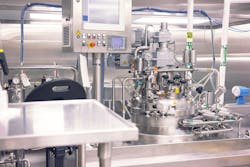Market Updates: Smart Pumps and Process Instrumentation
Analysis forecasts an increase in demand for smart pumps with focus on IIoT
Frost & Sullivan’s recent analysis, European Positive Displacement (PD) Pumps Market, Forecast to 2022, focuses on the application of PD pumps across various industries. The analysis reports that traditional product-based selling is giving way to solution-based selling as the European Positive Displacement (PD) Pumps Market experiences a surge in partnerships among original equipment manufacturers (OEMs) as well as automation and IT sectors. This business model allows pump manufacturers to position themselves as one-stop solution providers and meet the rising consumer demand for smart services. In addition to conventional services like pump installation, commissioning and decommissioning, they now offer predictive analytics, remote monitoring and virtual maintenance to enable cost savings, boost productivity and facilitate decision-making.
“The rise of cloud technologies, Industrial Internet of Things (IIoT), and synergies between IT and operational technology (OT) companies are enabling PD pump manufacturers to adopt the software-as-a-service (SaaS) model," said Srividhya Murali, senior research analyst for Industrial at Frost & Sullivan. “Using big data analytics, machine learning, and sensorization, smart pumps can help conserve energy by pumping out only the required levels of fluid.”
European Positive Displacement Pumps Market, Forecast to 2022, is part of Frost & Sullivan’s global Industrial Automation & Process Control Growth Partnership Service program. The pumps are segmented as rotary, reciprocating and peristaltic pumps. The study presents in-depth analysis of the drivers and restraints that impact the market as well as the political, economic and technological factors influencing investments in end-user industries.
“End-user industries’ desire for improved hygiene and reduced downtime is especially increasing the uptake of peristaltic and rotary pumps in the food and beverage, biotech and pharma sectors,” said Murali. “The market will also gain from the enforcement of the EU2020 strategy, which mandates the use of energy-efficient pumping solutions. Regulations and the increasing environment consciousness among end-users will cause existing pumps to be replaced with higher-performing, energy-efficient pumps.”
View the complete analysis at: http://frost.ly/2mb.
Process instrumentation and automation market projected to be $16B by 2022
The Measurement, Control & Automation Association (MCAA) published its Annual Market Forecast for 2018. Prepared by the analysts at Global Automation Research, the report focuses on the process instrumentation and automation (PI&A) markets in the U.S. and Canada. Twelve industry segments and product categories are examined, with a forecast timeline extending to the year 2022.
The 2017 process instrumentation and automation market in the U.S, valued at $13.4 billion, is projected to grow 3.7 percent by 2022 to a total of $16 billion. Growth will be concentrated in five industries: chemicals, electric utilities, oil refining, food and beverage, and pharmaceuticals. The cumulative market gain will be $2.7 billion over the forecast period. The chemicals industry market gain will be the largest. The market gain of the remaining slow-growing industries will equal about $484 million.
"The chemical industry is experiencing exceptional growth, driven largely by investments in ethylene/propylene and polyethylene/propylene new plant construction or major plant expansions," said Paul Rasmusson, president of Global Automation Research LLC. But he cautioned: "We are forecasting almost 5 percent annual growth in the U.S. chemicals process automation spending, but with ethylene prices at all-time lows, combined with major capacity additions in China and the Middle East, it is possible that some of the projects now under consideration may be delayed or cancelled, as the global ethylene/polyethylene markets play out over the forecast period."
Process control systems and process control valves continue to dominate the market value, accounting for 60 percent of the total for 2017. These two product categories will gain $1.4 billion in market value over the forecast period. The fastest growing product categories are electronic flow, electronic level, and remote I/O.
"Technology displacement remains the primary characteristic in the process automation market," said Rasmusson. "Down markets, such as that just experienced in the oil and gas sector, tend to accelerate displacement of older technologies because, as customer spending recovers, companies look for opportunities to reduce future costs, increase product output or quality, reduce environmental problem or increase safety through new technology options."
The market forecast also includes information for the Canadian process instrumentation and automation market, which is valued at $1,234 million and forecast to grow to $1,454 million by 2022, a five-year CAGR of 3.3 percent. Oil and gas spending has recovered along with growth in the Canadian chemical industry. Five industries — food and beverage, chemicals, pharmaceuticals, electric utilities, and oil refining — as a group, will grow above average, adding $153 million in market value over the forecast period.
The Industry Market Forecast is available to all MCAA members at no charge. Non-member organizations may purchase the report from www.TheMCAA.org.
